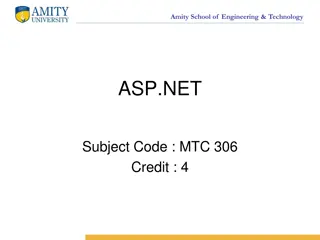Understanding Java ArrayList in Amity School of Engineering & Technology
Java ArrayList in Amity School of Engineering & Technology is a dynamic array used for storing elements without a size limit. It offers flexibility by allowing element addition and removal at any time. This type of array is part of the java.util package, similar to the Vector in C++. The ArrayList can contain duplicate elements, maintains insertion order, and is non-synchronized, allowing random access to elements. Despite being slower than standard arrays, ArrayList is helpful in scenarios requiring extensive array manipulation.
Download Presentation

Please find below an Image/Link to download the presentation.
The content on the website is provided AS IS for your information and personal use only. It may not be sold, licensed, or shared on other websites without obtaining consent from the author. Download presentation by click this link. If you encounter any issues during the download, it is possible that the publisher has removed the file from their server.
E N D
Presentation Transcript
Amity School of Engineering & Technology ArrayList 1
Amity School of Engineering & Technology ArrayList Java ArrayList class uses a dynamic array for storing the elements. It is like an array, but there is no size limit. We can add or remove elements anytime. So, it is much more flexible than the traditional array. It is found in the java.util package. It is like the Vector in C++.
Amity School of Engineering & Technology Cont.. The ArrayList in Java can have the duplicate elements also. It implements the List interface so we can use all the methods of List interface here. The ArrayList maintains the insertion order internally. It inherits the AbstractList implements List interface. class and
Amity School of Engineering & Technology Important Point Java ArrayList class can contain duplicate elements. Java ArrayList class maintains insertion order. Java ArrayList class is non synchronized. Java ArrayList allows random access because array works at the index basis. In ArrayList, manipulation is little bit slower than the LinkedList in Java because a lot of shifting needs to occur if any element is removed from the array list.
Amity School of Engineering & Technology Cont.. ArrayList is a part of collection framework and is present in java.util package. It provides us with dynamic arrays in Java. Though, it may be slower than standard arrays but can be helpful in programs where lots of manipulation in the array is needed. This in java.util package. class is found
Amity School of Engineering & Technology Constructors of ArrayList Constructor Description ArrayList() It is used to build an empty array list. ArrayList(Collection<? extends E> c) It is used to build an array list that is initialized with the elements of the collection c. ArrayList(int capacity) It is used to build an array list that has the specified initial capacity.
Amity School of Engineering & Technology Methods of ArrayList Method Description void add(int index, E element) It is used to insert the specified element at the specified position in a list. boolean add(E e) It is used to append the specified element at the end of a list. boolean addAll(Collection<? extends E> c) It is used to append all of the elements in the specified collection to the end of this list, in the order that they are returned by the specified collection's iterator. boolean addAll(int index, Collection<? extends E> c) It is used to append all the elements in the specified collection, starting at the specified position of the list. void clear() It is used to remove all of the elements from this list. void ensureCapacity(int requiredCapacity) It is used to enhance the capacity of an ArrayList instance.
Amity School of Engineering & Technology Cont.. E get(int index) It is used to fetch the element from the particular position of the list. boolean isEmpty() It returns true if the list is empty, otherwise false. Iterator() listIterator() int lastIndexOf(Object o) It is used to return the index in this list of the last occurrence of the specified element, or -1 if the list does not contain this element. Object[] toArray() It is used to return an array containing all of the elements in this list in the correct order. <T> T[] toArray(T[] a) It is used to return an array containing all of the elements in this list in the correct order.
Amity School of Engineering & Technology Cont.. Object clone() It is used to return a shallow copy of an ArrayList. boolean contains(Object o) It returns true if the list contains the specified element int indexOf(Object o) It is used to return the index in this list of the first occurrence of the specified element, or -1 if the List does not contain this element. E remove(int index) It is used to remove the element present at the specified position in the list. boolean remove(Object o) It is used to remove the first occurrence of the specified element. boolean removeAll(Collection<?> c) It is used to remove all the elements from the list.
Amity School of Engineering & Technology Non-generic Vs. Generic Collection Java collection framework was non-generic before JDK 1.5. Since 1.5, it is generic. Java new generic collection allows you to have only one type of object in a collection. Now it is type safe so typecasting is not required at runtime.
Amity School of Engineering & Technology Non Generic Example ArrayList list=new ArrayList(); //creating old non-generic arraylist New generic example of creating java collection. ArrayList<String> list=new ArrayList<String>(); //creating new generic arraylist In a generic collection, we specify the type in angular braces. Now ArrayList is forced to have the only specified type of objects in it. If you try to add another type of object, it gives compile time error.
Amity School of Engineering & Technology ArrayList Example import java.util.*; public class ArrayListExample1{ public static void main(String args[]){ ArrayList<String> list=new ArrayList<String>();//Creating arraylist list.add("Mango");//Adding object in arraylist list.add("Apple"); list.add("Banana"); list.add("Grapes"); //Printing the arraylist object System.out.println(list); } }
Amity School of Engineering & Technology Iterating ArrayList using Iterator import java.util.*; public class ArrayListExample2{ public static void main(String args[]){ ArrayList<String> list=new ArrayList<String>();//Creating arraylist list.add("Mango");//Adding object in arraylist list.add("Apple"); list.add("Banana"); list.add("Grapes"); //Traversing list through Iterator Iterator itr=list.iterator(); //getting the Iterator while(itr.hasNext()){ //check if iterator has the elements System.out.println(itr.next()); //printing the element and move tonext }
Amity School of Engineering & Technology Iterating ArrayList using For-each loop import java.util.*; public class ArrayListExample3{ public static void main(String args[]){ ArrayList<String> list=new ArrayList<String>(); list.add("Mango"); list.add("Apple"); list.add("Banana"); list.add("Grapes"); for(String fruit:list) System.out.println(fruit); } }
Amity School of Engineering & Technology Get and Set ArrayList The get() method returns the element at the specified index, whereas the set() method changes the element.
Amity School of Engineering & Technology Example import java.util.*; public class ArrayListExample4{ public static void main(String args[]){ ArrayList<String> al=new ArrayList<String >(); al.add("Mango"); al.add("Apple"); al.add("Banana"); al.add("Grapes");
Amity School of Engineering & Technology Cont.. //accessing the element System.out.println("Returning element: "+al.get(1)); //it will return the 2nd element, because index starts fro m 0 //changing the element al.set(1,"Dates"); //Traversing list for(String fruit:al) System.out.println(fruit); } }























